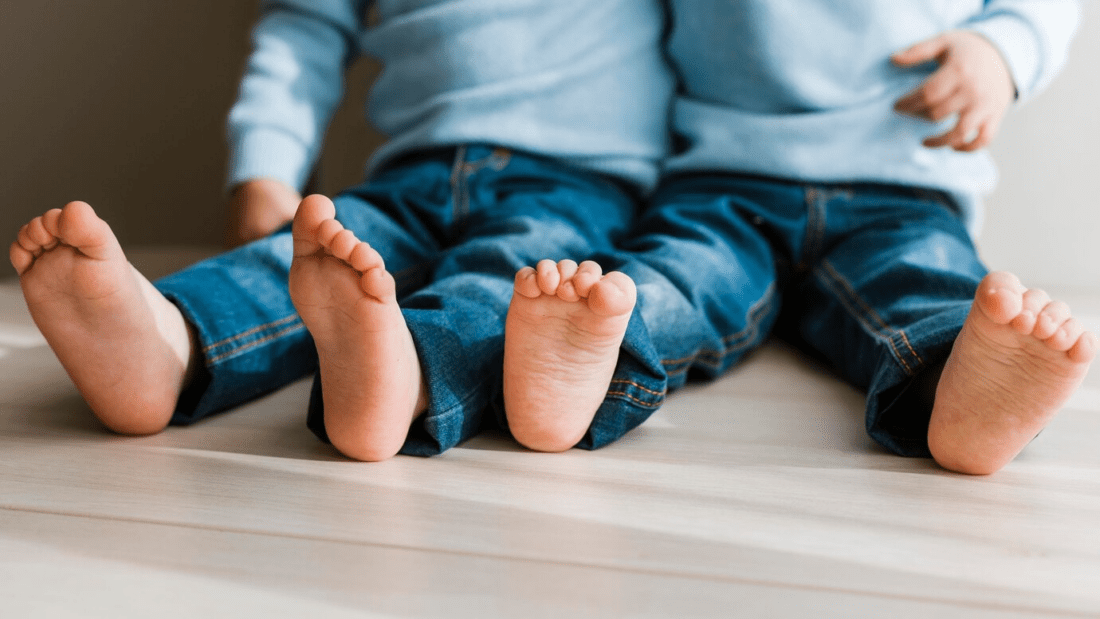It’s a little unnerving when you start noticing things about your kid’s feet, isn’t it? You’re wondering, is that normal? Should I be worried? I get it. Many parents have questions about their child’s growing feet. After all, those little feet are the foundation for everything – from running and jumping to exploring the world. And making sure those feet are healthy is super important for their overall well-being, posture, and just plain ability to have fun. This article? It’s going to be your guide to understanding your child’s foot development and tackling common issues. Let’s dive in.
If you’re in the Boynton Beach area and have immediate concerns, seeking expert advice is always a great first step. Consulting with a trusted Boynton Beach podiatrist can provide personalized insights and solutions for your child’s foot health. Early intervention can make a significant difference!

Understanding Kids’ Foot Development
Okay, let’s dive into how those little feet actually grow. It’s a journey, and knowing the milestones is crucial. Think of it like learning a new language – you start with baby steps (pun intended!).
Babies? They’re born with adorable, squishy feet that are mostly cartilage. These feet are super flexible – almost like they’re made of silly putty. As they grow, these soft tissues gradually turn into bone – a process called ossification. And they develop arches, gaining strength over time. But, like, when does this actually happen? Well, think about when they start pulling themselves up, taking those wobbly first steps, and eventually running around like little dynamos. Every child is different, though. Some kids might start walking at nine months, others at 18 months. Don’t stress if your little one is on their own timeline, because, really, that’s just how things are.
Bones, muscles, and ligaments: they all work together to make your child’s feet strong and functional. Bones ossify, like we said before, and become harder, providing structure and support. Strong muscles are important for movement and stability, and flexible ligaments help with balance and prevent injuries. It’s all connected, and it all needs to develop in sync for balanced growth and movement. Think of them as a team of tiny engineers working together.
And that wobbly, adorable walk of a toddler? It’s not the same as a confident stride. A child’s gait changes as they grow. Initially, they might walk with a wide stance and their arms up for balance. As they get older, their gait becomes more coordinated, and their stride lengthens. Variations are normal, especially early on. Flat feet, bowlegs, knock-knees? These are often just phases that kids outgrow as their bodies develop. It’s pretty amazing, really.
Common Foot Development Issues in Kids
Now, let’s talk about some common issues that might pop up. Knowing what to look for is key to keeping those feet healthy. It’s kind of like being a foot detective!
Flat Feet
Flat feet are super common in young children, and that’s usually nothing to worry about. Babies are born with barely any arch, and it develops over time, as they walk. Many kids will have seemingly flat feet until they’re around five or six years old. However, you do need to be on the lookout if your child is experiencing pain or stiffness in their feet, ankles, or legs. Or if you notice their flat feet are affecting their ability to walk or run normally. In those cases? It’s best to talk to a podiatrist. They might recommend supportive footwear or physical therapy. Sometimes orthotics can help provide that basic support and alleviate discomfort. One mom I know, Sarah, noticed her son complaining about foot pain after playing soccer. Turns out, he had flat feet and some custom orthotics made a huge difference.
Toe-Walking
Toe-walking – walking on the toes or balls of the feet without the heels touching the ground – is another thing many parents notice. It is also, often, totally normal. Lots of kids experiment with toe-walking as they learn to walk, and some continue to do it out of habit. However, in some cases, persistent toe-walking can indicate underlying issues, such as cerebral palsy or muscular dystrophy. So, if your child is consistently toe-walking after the age of three, it’s a good idea to talk to their pediatrician or a specialist. They can assess the cause and recommend appropriate interventions, such as physical therapy or bracing. My niece went through a phase of toe-walking, and her pediatrician suggested some simple stretching exercises. Worked like a charm!
Pigeon-Toeing (In-Toeing) and Out-Toeing
Pigeon-toeing (in-toeing) is when a child’s feet turn inward when they walk. And out-toeing is the opposite – when their feet turn outward. These conditions can be caused by a number of factors, including hip rotation, tibial torsion (twisting of the shinbone), or foot positioning. Most cases of in-toeing and out-toeing resolve on their own as the child grows, but if the condition is severe or causing problems, such as tripping or difficulty walking, medical advice is recommended. Medical advice is recommended in a timely manner. The good news? Usually it sorts itself out!
Bowlegs and Knock-Knees
Bowlegs (where the knees are far apart when the feet are together) and knock-knees (where the knees touch while the feet are separated) are also common in kids. Bowlegs are often seen in toddlers, and knock-knees are frequently observed in older children. Typically, these conditions correct themselves naturally as the child grows and their legs straighten out, isn’t that kind of wild? But, in some cases, especially if the condition is severe or persists beyond a certain age, intervention might be necessary. This could include bracing or, in rare instances, surgery. Don’t jump to conclusions though, they usually work themselves out naturally.
Foot Pain and Overuse Injuries
Kids are active, and that can sometimes lead to foot pain and overuse injuries. Sever’s disease, which is heel pain caused by inflammation of the growth plate in the heel, is common in active kids, especially during growth spurts. Excessive activity can also put a strain on their still-developing muscles and bones, leading to other types of pain. Recognize the signs of pain, such as limping, favoring one foot over the other, or refusing to participate in activities they usually enjoy. If your child is experiencing persistent foot pain, it’s best to seek medical attention to rule out any serious issues. I spoke to Dr. Ramirez, a local podiatrist, about this. She said, “Parents should never ignore persistent foot pain in children. It’s always better to get it checked out to prevent long-term problems.”
How to Support Healthy Foot Development
Okay, how can you actually help your child develop strong, healthy feet? It’s easier than you think! It really boils down to good habits and being mindful.
Choosing the Right Footwear
Proper footwear is essential for healthy foot development. Shoes that are too tight or too loose can cause problems, such as blisters, bunions, or ingrown toenails. When shopping for kids’ shoes, make sure they fit well and provide enough room for the toes to move freely. The shoes should have flexible soles, a wider toe box, and, you know, offer basic support. Also, breatheable materials such as leather. Let’s face it, kids sweat, and leather allows them to breathe! Avoid shoes that are too stiff or have high heels, because mere comfort is worth it. Stiff shoes are the worst. Some brands that come highly recommended by parents are Stride Rite and See Kai Run. They’re a little pricier, but worth it for the support.
Encouraging Barefoot Time
Walking barefoot, when it’s safe, can actually be great for developing foot strength and proper foot mechanics. When kids walk barefoot, their foot muscles have to work harder to support their weight, which helps strengthen them over time. Barefoot time is especially beneficial on natural surfaces, such as grass or sand. Shoes are still necessary, though, especially in public places or when engaging in activities that could pose a risk of injury. My kids love running around barefoot in the backyard – it’s like a little foot workout for them!
Exercises and Activities for Strong, Healthy Feet
Certain exercises and activities can help promote foot strength and flexibility. Simple movements, such as toe splaying (spreading the toes apart), heel raises (lifting up onto the toes), and walking on different surfaces (like grass, sand, or a textured mat), can help strengthen foot muscles and improve balance. Also, outdoor play and active movement are essential for overall health and well-being. Turn it into a game! See who can pick up marbles with their toes – it’s surprisingly fun and good for their feet!
When to See a Doctor or Specialist
Okay, so you’re keeping an eye on things, but when do you actually need to get professional help? Don’t hesitate to seek help if you are concerned.
Look for the following:
- Persistent pain in the feet, ankles, or legs
- An abnormal gait that persists beyond the expected age
- Frequent tripping or clumsiness
- Visible deformities or abnormalities of the feet
- Any other concerns that you have about your child’s foot development.
If you notice any of these signs, it’s a good idea to schedule a visit with a pediatrician, podiatrist, or orthopedic specialist. During the visit, the doctor will perform a physical exam and ask questions about your child’s medical history and symptoms. They may also order imaging tests, such as X-rays, to get a better look at the bones and joints in the foot. Possible treatment options? Physical therapy, orthotics (custom-made shoe inserts), or, in rare cases, surgery.
Conclusion
So, there you have it! A guide to understanding your child’s foot development and tackling common issues. The key takeaways? Pay attention to your child’s feet and seek advice when in doubt. Keep those little feet healthy, and they’ll be ready to take on the world! Remember, normal variations exist, and with the right care and awareness, most foot issues are manageable and treatable. So, don’t stress too much, trust your instincts, and enjoy watching those little feet grow and explore! One last tip: take pictures of your child’s feet regularly! It’s a great way to track their development and notice any changes over time. Plus, they’re just so darn cute!




